Electronics News
Archive : 4 September 2015 год
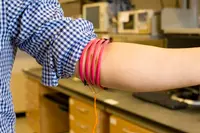 Engineers at the University of California, San Diego have demonstrated a wireless communication technique that works by sending magnetic signals through the human body.
Engineers at the University of California, San Diego have demonstrated a wireless communication technique that works by sending magnetic signals through the human body.
"In the future, people are going to be wearing more electronics, such as smart watches, fitness trackers and health monitors. All of these devices will need to communicate information with each other," Patrick Mercier, a professor at UC San Diego who led the study, said. "Currently, these devices transmit information using Bluetooth radios, which use a lot of power to communicate. We're trying to find new ways to communicate information around the human body that use much less power."
In this study, the engineers demonstrated a technique called magnetic field human body communication, which uses the body as a vehicle to deliver magnetic energy between electronic devices. An advantage of this system is that magnetic fields are able to pass freely through biological tissues, providing lower power consumption.
"This technique, to our knowledge, achieves the lowest path losses out of any wireless human body communication system that's been demonstrated so far. This technique will allow us to build much lower power wearable devices," said Mercier.
Another potential advantage of magnetic field human body communication is that it could offer more security than Bluetooth networks.
The researchers also pointed out that this technique does not pose any serious health risks. Since this technique is intended for applications in ultra low power communication systems, the transmitting power of the magnetic signals sent through the body is expected to be many times lower than that of MRI scanners and wireless implant devices.
Author
Tom Austin-Morgan
Source: www.newelectronics.co.uk
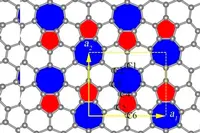 Scientists from Russia, the US and China have predicted the existence of phagraphene, which they describe as a 'patchwork' analogue of graphene.
Scientists from Russia, the US and China have predicted the existence of phagraphene, which they describe as a 'patchwork' analogue of graphene.
"Unlike graphene, a hexagonal honeycomb structure with atoms of carbon at its junctions," said team leader Artyom Oganov from the Moscow Institute of Physics and Technology, "phagraphene consists of penta, hexa and heptagonal carbon rings."
In graphene, each carbon atom has three electrons bound to electrons in neighbouring atoms. The fourth electron of each atom is 'delocalised', which allows graphene to conduct electricity. However, delocalised electrons in graphene behave strangely: they all have the same velocity, possess no inertia and appear to have no mass – properties dictated by so called Dirac cones.
Phagraphene – expected to have the same properties as graphene – also features Dirac cones and electrons behave similarly. "In phagraphene, due to the different number of atoms in the rings, the Dirac cones are 'inclined'," said Oganov. "That is why the velocity of electrons in it depends on the direction. It would be very interesting to see where it might be useful to vary the electron velocity."
Author
Graham Pitcher
Source: www.newelectronics.co.uk
 Electrical and computer engineers at North Carolina State University claim to have developed a technique for creating less-expensive, low-power embedded systems.
Electrical and computer engineers at North Carolina State University claim to have developed a technique for creating less-expensive, low-power embedded systems.
"Using our techniques, we've been able to create prototype systems with power converters that have a combination of energy efficiency and low cost that - as far as we've been able to tell - is unmatched by anything currently on the market," says Alex Dean, associate professor of electrical and computer engineering at NC State.
The team has used design principles from real-time systems and incorporated power converter software into the embedded system processor. These methods are said to guarantee that the other software on the embedded system's processor will not disturb the power converter's correct operation. Eliminating the need for a separate processor or controller circuit on the power converter itself, this in turn makes the overall system less expensive, smaller, lighter and more flexible.
"Because the embedded system software and power converter software are using a shared processor on a single chip, it gives developers more coordinated control over both the system's functions and related demands those functions may make on the power converter," Dean says.
The researchers made two prototype converters using the technique and compared them to other compatible power converters on the market. They found that none of the other converters could match the prototypes' combination of low cost and high efficiency.
"Our second-best prototype had 90% efficiency - less than 10% of the energy was wasted," Dean says. "Our best prototype had 95% efficiency. And both had component costs of about 50¢. All other converters either cost more, were less efficient or both."
Pic: Alex Dean, associate professor of electrical and computer engineering at NC State.
Author
Tom Austin-Morgan
Source: www.newelectronics.co.uk
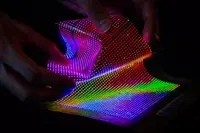 Researchers from Holst Centre, imec and CMST, imec's associated lab at Ghent University, have demonstrated what they claim to be the world's first stretchable and conformable thin-film transistor (TFT) driven LED display laminated into textiles. This paves the way to wearable displays in clothing providing users with feedback.
Researchers from Holst Centre, imec and CMST, imec's associated lab at Ghent University, have demonstrated what they claim to be the world's first stretchable and conformable thin-film transistor (TFT) driven LED display laminated into textiles. This paves the way to wearable displays in clothing providing users with feedback.
Wearable devices such as healthcare monitors and activity trackers are becoming more commonplace however; they are separate devices that users must remember to wear. The researchers say that integrating these devices into our clothing will make wearable devices less obtrusive and more comfortable, encouraging people to use them more regularly and increase the quality of data collected.
"Wearable devices allow people to monitor their fitness and health so they can live full and active lives for longer," said Edsger Smits, senior research scientist at Holst Centre. "But to maximise the benefits wearables can offer, they need to be able to provide feedback on what users are doing as well as measuring it.
"By combining imec's patented stretch technology with our expertise in active-matrix backplanes and integrating electronics into fabrics, we've taken a giant step towards that possibility."
The display is thin and mechanically stretchable. Small LEDs are mounted on an amorphous indium-gallium-zinc oxide TFT backplane that employs a two-transistor and one capacitor pixel engine to drive the LEDs. These second-generation displays are said to offer higher pitch and increased, average brightness. Work is ongoing to further industrialise this technology.
Author
Tom Austin-Morgan
Source: www.newelectronics.co.uk
 Intel has launched what it calls its best processor yet. According to the company, the 6th Generation Intel Core processor family delivers enhanced performance at the lowest power levels yet while supporting designs ranging from compute sticks to mobile workstations.
Intel has launched what it calls its best processor yet. According to the company, the 6th Generation Intel Core processor family delivers enhanced performance at the lowest power levels yet while supporting designs ranging from compute sticks to mobile workstations.
"6th Gen Intel Core processors deliver some of the most significant advancements in computing that we've seen," said Kirk Skaugen, general manager of Intel's Client Computing Group. "New 6th Gen Intel Core based systems are more responsive than ever, with enhanced performance, battery life and security."
Featuring the Skylake microarchitecture and manufactured on Intel's 14nm process technology, the processor family is said to include several firsts for mobile designs, including a mobile K SKU that is unlocked to enable overclocking, a quad core Core i5 processor that offers improved mobile multitasking and the Xeon E3 processor family for mobile workstations.
The Skylake architecture, in development for more than four years, delivers high processor and graphics performance, high resolution video playback. According to Intel, the architecture brings an improvement in energy efficiency of up to 60% for some versions, whilst enabling higher performance.
The family spans a range of applications. At the desktop end, the Core i7-6700K is available in quad and octa core variants, supporting clock rates of up to 4.2GHz and drawing 91W. However, at the other end of the scale, the Core m7-6Y75 – available in dual and quad core variants – runs at up to 3.1GHz, but draws only 4.5W.
Author
Graham Pitcher
Source: www.newelectronics.co.uk
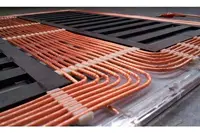 Researchers at the Fraunhofer Institute for Wind Energy and Energy System Technology IWES in Kassel claim to have come up with a more cost-effective design for inductive electric car charging systems.
Researchers at the Fraunhofer Institute for Wind Energy and Energy System Technology IWES in Kassel claim to have come up with a more cost-effective design for inductive electric car charging systems.
"We deliberately use standard components that are already available on the mass market," explained Marco Jung, deputy head of the converter technology department at Fraunhofer IWES.
Another advantage is the specially designed power electronics and coil systems, which means that the system works efficiently even when the coil in the car is 20cm from the coil in the road.
"Even with an air gap of 20cm, we achieve an efficiency of between 93 and 95%, and do so across the entire power range, from 400W to 3.6kW," said Dr René Marklein, project manager at Fraunhofer IWES.
As well as charging the batteries, the system can also discharge them. This can help to stabilise the general power grid when there is a surplus thanks to all day sun or strong winds over-charging the grid. The researchers say that car batteries could be used as a sort of buffer, the surplus electricity could be stored there temporarily and then fed back into the grid when the sun clouds over or the winds die down.
Current electric cars have a limited range. However, researchers at the Fraunhofer Institutes for Manufacturing Technology and Advanced Materials IFAM and for Transportation and Infrastructure Systems IVI say it will become possible to charge cars while they are moving. This team has constructed a 25m test route along which coils have been set into the road. The team succeeded in driving an electric vehicle along the strip at a moderate speed while simultaneously charging its battery.
Author
Tom Austin-Morgan
Source: www.newelectronics.co.uk
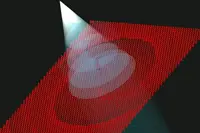 Researchers from NASA's Jet Propulsion Laboratory and the California Institute of Technology have developed flat optical lenses said to be capable of manipulating light in ways that have been difficult or impossible to achieve with conventional optical devices.
Researchers from NASA's Jet Propulsion Laboratory and the California Institute of Technology have developed flat optical lenses said to be capable of manipulating light in ways that have been difficult or impossible to achieve with conventional optical devices.
The lenses are made of silicon nanopillars arranged into a honeycomb pattern. It is this 'metasurface' that allows light waves to be controlled.
"Currently, optical systems are made one component at a time and the components are often assembled manually," said Andrei Faraon, an assistant professor at Caltech. "But this new technology is very similar to the one used to print semiconductor chips onto silicon wafers, so you could conceivably manufacture millions of systems – such as microscopes or cameras – at a time."
Each nanopillar has an elliptical cross section and, by carefully varying the size of each pillar and rotating them around their axes, the scientists could manipulate the phase and polarisation of passing light simultaneously.
"If you think of a modern microscope," Faraon noted, "it has multiple components that have to be carefully assembled inside. With our platform, we can make each of these optical components and stack them atop one another very easily using an automated process. Each component is just 1µm thick."
The lenses may also be used to modify the shape of light beams. According to the team, semiconductor lasers typically emit elliptical beams that are hard to work with. New metasurface optical components could replace expensive optical systems used to make these beams circular and allow more compact systems to be created.
Author
Graham Pitcher
Source: www.newelectronics.co.uk
 Findlay Media has revealed the full conference and workshop programme for EDS 2015. EDS incorporates the Engineering, Electronics and Embedded Design Shows, which are being held on 21 and 22 October at the Jaguar Exhibition Hall, Ricoh Arena, Coventry.
Findlay Media has revealed the full conference and workshop programme for EDS 2015. EDS incorporates the Engineering, Electronics and Embedded Design Shows, which are being held on 21 and 22 October at the Jaguar Exhibition Hall, Ricoh Arena, Coventry.
Two conference theatres will feature keynote sessions from leading engineering design experts drawn from the worlds of Motorsport, Aerospace, Healthcare, Automotive, Telecoms, Manufacturing and Marine.
Delegates will hear how the Williams F1 team's Advanced Engineering group is transferring technology developed for F1 to road cars and into Formula E race cars.EE will discuss the future of 5G communications development and Land Rover BAR will explain how advanced engineering is giving the Ben Ainslie team a fighting chance of the UK winning the Americas Cup for the first time.Further highlights include ARM discussing how to achieve connected, secure and simple IoT deployments and the Renfrew Group will explain how clever engineering can help in the fight against the spread of diseases.
An extensive workshop programme of inspiring case studies and practical design advice runs alongside and delegates can earn CPD points at the iED approved sessions.The EDS exhibition is the UK's most comprehensive event of its type and will pack the Jaguar Exhibition Hall with more than 200 companies highlighting products, services and innovations specifically for the UK's design engineering communities.
Registering for the event is quick and easy and will guarantee entry to this free event. Once registered, visitors can select the workshop and conference sessions they would like to attend; and with space limited on each session, it is recommended visitors book early to avoid disappointment.
Author
Tom Austin-Morgan
Source: www.newelectronics.co.uk
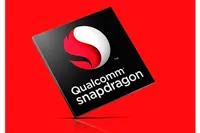 The forthcoming Qualcomm Snapdragon 820 processor will feature a machine learning based approach said to support 'accurate and effective detection' of zero day malware threats. Called Snapdragon Smart Protect, the approach is also said to be the first application to use Qualcomm Zeroth technology, in which conventional anti malware solutions are augmented using an advanced cognitive computing behavioural engine.
The forthcoming Qualcomm Snapdragon 820 processor will feature a machine learning based approach said to support 'accurate and effective detection' of zero day malware threats. Called Snapdragon Smart Protect, the approach is also said to be the first application to use Qualcomm Zeroth technology, in which conventional anti malware solutions are augmented using an advanced cognitive computing behavioural engine.
The forthcoming Qualcomm Snapdragon 820 processor will feature a machine learning based approach said to support 'accurate and effective detection' of zero day malware threats. Called Snapdragon Smart Protect, the approach is also said to be the first application to use Qualcomm Zeroth technology, in which conventional anti malware solutions are augmented using an advanced cognitive computing behavioural engine.
"With consumers storing more personal information on their devices, data leakage incidents and malware are on the rise," said Asaf Ashkenazi, Qualcomm Technologies' director of product management. "Qualcomm Technologies is equipped to address these issues with our ability to access lower layers of the software stack and dedicated security hardware, to create a device-based, behavioural analysis approach for mobile security."
Smart Protect is said to complement signature based anti malware solutions by analysing and identifying new threats prior to new signature updates. OEMs and mobile anti malware application providers can also use Snapdragon Smart Protect APIs to perform causal analysis, offering users and the mobile industry real-time information of identified threats.
"Snapdragon Smart Protect supports deep on device monitoring for nearly instantaneous notifications of detected privacy violations and malicious activity while also providing great system performance and battery life," Ashkenazi added.
Smart Protect is expected be available in consumer devices featuring the Snapdragon 820 in 2016.
Author
Graham Pitcher
Source: www.newelectronics.co.uk
 Basingstoke-based EC Electronics have announced the acquisition of Subassembly Services (SAS). As part of the EC group, SAS will continue to trade independently with its established customer base from its factory in Tewkesbury.
Basingstoke-based EC Electronics have announced the acquisition of Subassembly Services (SAS). As part of the EC group, SAS will continue to trade independently with its established customer base from its factory in Tewkesbury.
Group managing director, Phil Simmonds said: "SAS adds significant capacity to our UK manufacturing capabilities and we expect to see some major growth in our business over the coming months.
"We are confident that the integration of existing EC and SAS manufacturing services will significantly benefit both customer bases. In particular, the pooling of our manufacturing resources will increase our ability to provide additional capacity when and where required across the whole customer base," Simmonds continued.
In addition to volume manufacture of PCB Assemblies, EC can now offer customers Cable and Wire Harness Assembly, Electronics Encapsulation via Low Pressure Overmoulding for the protection of PCB Assemblies and Grommet and strain relief for Cable Assemblies.
In terms of supply chain services, EC says it can also offer SAS customers potential material cost down on components they purchase for their final assemblies, via the Group's Supply Chain Solutions, whose Hong Kong office manage and regularly audit manufacturers based in China and South East Asia.
The acquisition will facilitate the retirement of SAS founders Maggie Todd and Chris Powell, once the handover has been achieved.
Pic: Phil Simmonds, managing director of EC Electronics
Author
Tom Austin-Morgan
Source: www.newelectronics.co.uk

